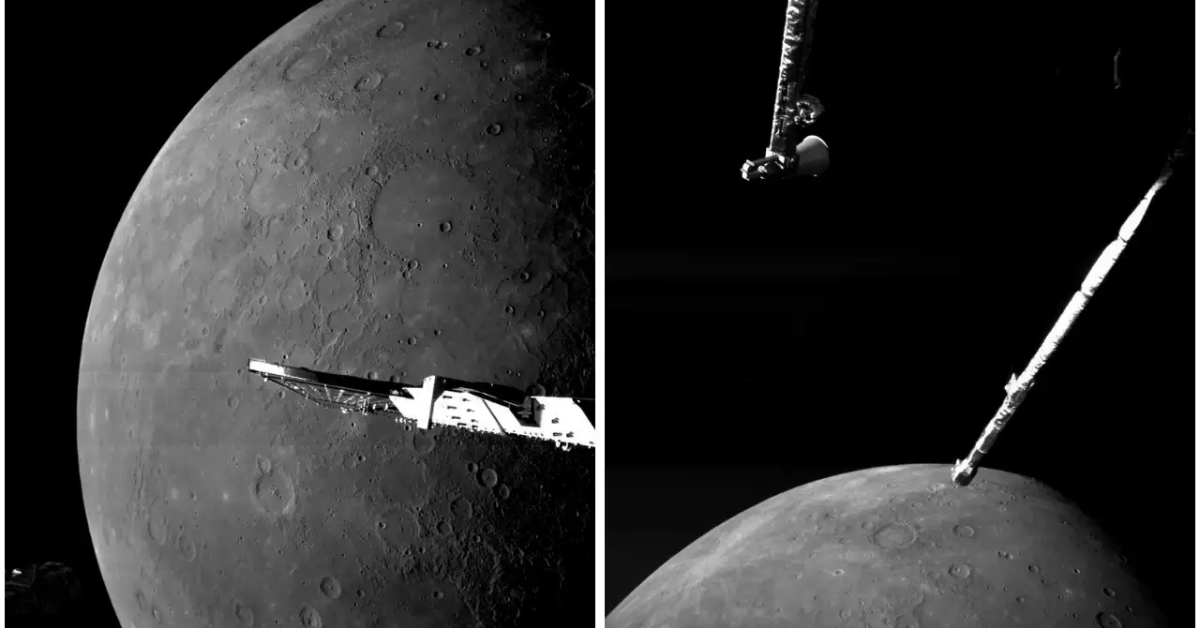A spacecraft has just sent back some of the most detailed images of Mercury’s north pole. This incredible achievement comes from a joint European and Japanese mission, which recently captured close-up shots of the planet’s surface, offering new insights into the mysteries of our solar system’s smallest planet.
The spacecraft made a daring pass just 183 miles above the night side of Mercury, flying directly over its north pole. The images, released by the European Space Agency (ESA), reveal fascinating details of the planet’s surface, including craters that are in permanent shadow. These areas are believed to contain frozen water, a discovery that could have significant implications for future space exploration.
What Makes These Images Special?
The spacecraft’s pass was not just another routine flyby. It took place over the “terminator” – the line where Mercury’s day meets its night. This unique vantage point allowed the spacecraft to capture images of the dark craters at the planet’s north pole, areas that are never exposed to sunlight. ESA has highlighted that these craters might contain frozen water and further investigation will be carried out as the spacecraft enters Mercury’s orbit.
Apart from the impressive shots of the North Pole, the spacecraft also captured other features of Mercury’s surface. These include expansive volcanic plains and Mercury’s largest impact crater, which spans a massive 930 miles.
The BepiColombo Mission
This remarkable flyby was the sixth and final close approach of Mercury for the BepiColombo spacecraft. Since its launch in 2018, BepiColombo has been conducting flybys to gather crucial data on Mercury’s atmosphere and surface. The spacecraft is now set on a path to enter orbit around Mercury by late next year.
Named after Giuseppe Colombo, a pioneering Italian mathematician, the spacecraft is a collaborative effort between the European Space Agency (ESA) and the Japan Aerospace Exploration Agency (JAXA). It carries two orbiters – one for Europe and one for Japan – that will work together to study Mercury from different angles, focusing on the planet’s poles.
A Legacy of Exploration
The BepiColombo mission is a tribute to the late Giuseppe Colombo, whose work helped shape our understanding of Mercury. Colombo’s contributions to NASA’s Mariner 10 mission in the 1970s, as well as his involvement in the Italian Space Agency’s tethered satellite project, have left a lasting impact on space exploration.
According to the BBC, Although the main mission phase for BepiColombo won’t start until 2026, the spacecraft’s flybys have already provided invaluable data. The BepiColombo team is now working to analyze the latest findings and uncover even more secrets about the planet closest to the Sun.
Looking Ahead: What’s Next for BepiColombo?
As BepiColombo moves closer to its final destination, scientists are eager to see what new discoveries lie ahead. With its orbit set to take it around Mercury, the spacecraft will continue to send back crucial data about the planet’s surface, atmosphere, and potential for supporting life.
This mission will help us learn more about Mercury’s history, including the role that frozen water may have played in shaping its environment. It will also provide vital information about the planet’s volcanic activity and the large impact craters that cover its surface.
The journey of the BepiColombo spacecraft represents a major leap forward in our exploration of the solar system. As the spacecraft continues to explore the mysteries of Mercury, it promises to answer many questions and raise new ones. For now, we can only wait for the exciting discoveries that lie ahead.
Disclaimer: This article has been meticulously fact-checked by our team to ensure accuracy and uphold transparency. We strive to deliver trustworthy and dependable content to our readers.







Leave a Comment